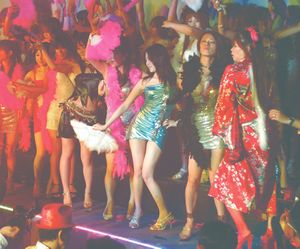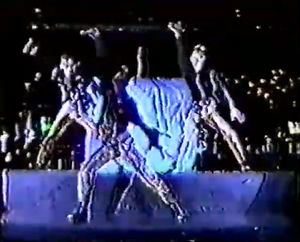TechPara: Difference between revisions
No edit summary |
No edit summary |
||
| Line 3: | Line 3: | ||
'''TechPara (テクパラ)''' is a variant dance of ParaPara. It is mainly danced to hyper techno and eurodance. | '''TechPara (テクパラ)''' is a variant dance of ParaPara. It is mainly danced to hyper techno and eurodance. | ||
It is important to point out that techno in the TechPara culture does not necessarily | It is important to point out that techno in the TechPara culture does not necessarily refer to techno as a musical genre, but instead as a shortened version of the phrase "techno parapara" or even dance music loosely marketed as "techno". | ||
TechPara sometimes incorporates genres such as j-pop and rock, and the distinction between TechPara and other dances like yogore or TraPara | TechPara sometimes incorporates genres such as j-pop and rock, and the distinction between TechPara and other dances like yogore or TraPara can be difficult to differentiate. | ||
== History == | == History == | ||
=== Juliana's Tokyo and the beginning (1991-93) === | === Juliana's Tokyo and the beginning (1991-93) === | ||
TechPara origins | TechPara's origins can be traced back to the Juliana's Tokyo opening in Japan and its popularity in the early 1990s. At that time, a lot of house and rave genres were introduced and they became known among Japanese clubbers as 'Juliana's techno" (ジュリテク). | ||
[[File:DeLjN2SVQAAP cV.jpg|thumb]] | [[File:DeLjN2SVQAAP cV.jpg|thumb]] | ||
In the Juliana's era, the dancing wasn't | In the Juliana's era, the dancing wasn't called TechPara and was mainly freestyle. The symbol of Juliana's was the feathered fan dancing. Fans were brought into TechPara because of the Kyoto scene and it's geisha neighborhood. The fad started when Maikos (young geishas) used to go to the local Maharaja carrying feathered fans. Girls wearing bodycon (body contour) dresses and boas danced on the otachidai, driving the male crowds crazy. The sexy dancing of Juliana's became it's trademark and media covered the boom extensively. At the height of it's popularity, Juliana's was an expensive place and it's customers were all adults that also used to go to other discos from Tokyo where the dress code was strict and chic. The sexy atmosphere and the media coverage created the misguided idea that Juliana's was a form of strip club and one of the reasons for its demise and attendance drop. | ||
After | After its closure, some of Juliana's regulars started to go to ParaPara clubs and Juliana's techno and hyper techno began to be played along with eurobeat sets. The end of Juliana's boom is close to the start of the second ParaPara boom, so it is no surprise that both types of dance merged at this point. Xenon, one of the biggest ParaPara clubs of that generation, did some of what could be called the "first" TechPara choreographies. There is little data about that information but it is meaningful that one of Xenon's ParaPara tapes is solely dedicated to TechPara with songs like "survival dAnce" by TRF and [[Baila Baila (DJ Zorro) | Baila Baila]] by [[DJ Zorro]]. There are other Xenon videos with TechPara dances and even some with vogue dancing. It is also a good record to illustrate how modern TechPara started and incorporated various dance styles in its birth. | ||
As early ParaPara dances, the first TechPara choreographies were very simple and repetitive. Many incorporated freestyle dancing and there was no such thing as standard way to dance it or a standard style. James Brown Is Dead, Can't undo This, Tokyo Go!, Beats Go, Arriba Arriba and Bandido are some of | As early ParaPara dances, the first TechPara choreographies were very simple and repetitive. Many incorporated freestyle dancing and there was no such thing as standard way to dance it or a standard style. James Brown Is Dead, Can't undo This, Tokyo Go!, Beats Go, Arriba Arriba and Bandido are some of these early choreographies. They aren't danced as often as they were in the 1990s and some steps have changed drastically. | ||
[[File:Sem Título-1.jpg|thumb]] | [[File:Sem Título-1.jpg|thumb]] | ||
Revision as of 17:47, 7 February 2021
TechPara
TechPara (テクパラ) is a variant dance of ParaPara. It is mainly danced to hyper techno and eurodance.
It is important to point out that techno in the TechPara culture does not necessarily refer to techno as a musical genre, but instead as a shortened version of the phrase "techno parapara" or even dance music loosely marketed as "techno".
TechPara sometimes incorporates genres such as j-pop and rock, and the distinction between TechPara and other dances like yogore or TraPara can be difficult to differentiate.
History
Juliana's Tokyo and the beginning (1991-93)
TechPara's origins can be traced back to the Juliana's Tokyo opening in Japan and its popularity in the early 1990s. At that time, a lot of house and rave genres were introduced and they became known among Japanese clubbers as 'Juliana's techno" (ジュリテク).
In the Juliana's era, the dancing wasn't called TechPara and was mainly freestyle. The symbol of Juliana's was the feathered fan dancing. Fans were brought into TechPara because of the Kyoto scene and it's geisha neighborhood. The fad started when Maikos (young geishas) used to go to the local Maharaja carrying feathered fans. Girls wearing bodycon (body contour) dresses and boas danced on the otachidai, driving the male crowds crazy. The sexy dancing of Juliana's became it's trademark and media covered the boom extensively. At the height of it's popularity, Juliana's was an expensive place and it's customers were all adults that also used to go to other discos from Tokyo where the dress code was strict and chic. The sexy atmosphere and the media coverage created the misguided idea that Juliana's was a form of strip club and one of the reasons for its demise and attendance drop.
After its closure, some of Juliana's regulars started to go to ParaPara clubs and Juliana's techno and hyper techno began to be played along with eurobeat sets. The end of Juliana's boom is close to the start of the second ParaPara boom, so it is no surprise that both types of dance merged at this point. Xenon, one of the biggest ParaPara clubs of that generation, did some of what could be called the "first" TechPara choreographies. There is little data about that information but it is meaningful that one of Xenon's ParaPara tapes is solely dedicated to TechPara with songs like "survival dAnce" by TRF and Baila Baila by DJ Zorro. There are other Xenon videos with TechPara dances and even some with vogue dancing. It is also a good record to illustrate how modern TechPara started and incorporated various dance styles in its birth.
As early ParaPara dances, the first TechPara choreographies were very simple and repetitive. Many incorporated freestyle dancing and there was no such thing as standard way to dance it or a standard style. James Brown Is Dead, Can't undo This, Tokyo Go!, Beats Go, Arriba Arriba and Bandido are some of these early choreographies. They aren't danced as often as they were in the 1990s and some steps have changed drastically.

